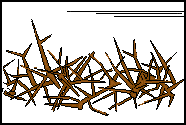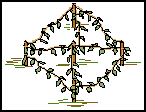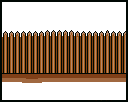Civil War Field Fortifications
Common
Obstacles
|
Abatis |
|
|
|
 |
|
An abatis was a well arranged tangle of large limbs or whole trees felled
and laid in a line with the branches pointed toward the enemy. Smaller branches
and leaves were stripped off and the remaining branches were sharpened into
points. The ends pointing toward the field work could be covered with soil,
staked to the ground, or nailed together with cross beams to prevent the
enemy from easily dismantling the abatis as they advanced against the work.
In many cases during the Civil War abatises were formed by simply cutting
trees in front of a work and letting them lay where they fell which both
created an obstacle and clear fields of fire from the work. |
|
|
|
|
|
Chevaux-de-frise |
|
|
|
 |
|
Chevaux-de-frise were useful for the obstruction of roads and intervals between
field works where it was undesirable to construct more permanent and unmovable
types of obstructions. They could also be used where the ground was either
too hard or too soft to erect palisadings or stockades. Chevaux-de-frise
could stop cavalry dead in its tracks, but really weren't a serious obstacle
to the passage of infantry. Because chevaux-de-frise were time consuming
to construct and required special tools and some carpentry skill to bore
the holes for the cross stakes (called lances) they were generally only used
where armies had plenty of time and labor available to develop their field
works. Like all wooden field works they could be shattered by artillery very
quickly. |
|
|
|
|
|
Entanglements |
|
|
|
 |
|
Entanglements were obstacles built low to the ground to snarl the feet and
trip attacking troops. There were several common ways to fashion enetanglements.
Small trees around a work could be cut half-way through their trunks about
18 inches above the ground and the top pulled over and staked down
in a direction perpendicular to the enemy's expected line of advance. Small
straight branches about three feet long could be driven into the ground in
a quincunx pattern with vines and the branches of prickly shrubs intertwined
among the stakes. It was a small jump to go from using vines to stringing
telegraph wire between stumps to create wire entanglements. |
|
|
|
|
|
Palisadings |
|
|
|
 |
|
Palisadings were lines of closely space palisades planted vertically or at
about a 45 degree upward angle. They could be used at the foot of the
counterscarp to give enemy troops something seriously ugly to think about
as they descended into the ditch or they could be used to cover the rear
of field works open at the gorge. Several lines of palisadings, with the
palisades widely spaced, were occaisonally used in front of field works in
place of an abatis. As with fraises and chevaux-de-frise, palisadings were
vulnerable to artillery fire and could be knocked to pieces very quickly. |
|
|
|
|
|
Stockades |
|
|
|
 |
|
Stockades were constructed using the trunks of small trees between nine
and twelve inches in diameter. The larger trunks were placed side by side
in a line with the smaller trunks positioned to cover the joins between the
larger trunks. Although stockades were actually a type of wooden field work
in their own right they could be used in place of palisades when a
more substantial obstacle was required. Being a wooden construction stockades
were usually only used where they could not be threatened by direct artillery
fire. |
|
|
|
|
Other less common types of obstacles such as inundations,
fraises, and trous de loup are covered in the
Glossary.
Back to Major Works
Contents
Home Page
Minor Works
Siege Works
Permanent Fortifications
Glossary
Copyright (c) PEM 1997, 1998




